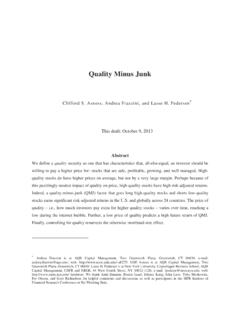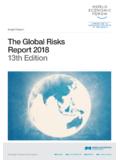Transcription of What are the effects of macroprudential policies on ...
1 BIS Quarterly Review, September 2017 71 What are the effects of macroprudential policies on macroeconomic performance?1 macroprudential policies are designed to make financial crises less likely or less severe. At the same time, they might also curb output growth by affecting credit supply and investment. Using data for a panel of 64 advanced and emerging market economies, this special feature investigates empirically the effects of macroprudential policies on long-run economic performance. We find that countries that more frequently use macroprudential tools, other things being equal, experience stronger and less volatile GDP growth. These effects are influenced by each economy s openness and financial development. Finally, we find that non-systematic macroprudential interventions tend to be detrimental to growth. JEL classification: G10, G21, O16, O40.
2 Long before the term even existed, macroprudential policies were used to address financial stability concerns, particularly among emerging market economies (EMEs). Their popularity has greatly increased in recent years, especially during and after the Great financial Crisis (GFC) of 2007 09. Yet our understanding of these policies , and their effects on macroeconomic performance, is still open to debate. For example, while the use of macroprudential policies is typically motivated by the need to contain systemic risk and thus contribute to macroeconomic stability (IMF-FSB-BIS (2011, 2016), Galati and Moessner (2017)), it has also been suggested that these policies could harm economic activity (S nchez and R hn (2016)).2 macroprudential interventions should be judged primarily on whether they reduce the occurrence of financial crises , their ultimate goal.
3 Alas, measuring this capability remains an elusive task, given the relative infrequency of crises , and the difficulty of precisely attributing them to fundamental factors. One possible way of assessing the effectiveness of macroprudential policies is to evaluate their impact on economic growth and its volatility over the long term. These two measures of effectiveness are closely linked to economic well-being, and could thus be seen as a 1 The authors would like to thank Pierre-Richard Ag nor, Yavuz Arslan, Claudio Borio, Stijn Claessens, Benjamin Cohen, Dietrich Domanski, Mathias Drehmann, Ingo Fender, Enisse Kharroubi, Hyun Song Shin, Nikola Tarashev and Kostas Tsatsaronis for useful comments and suggestions. The views expressed are those of the authors and do not necessarily reflect those of the BIS. 2 See also Fender and Lewrick (2016) for a cost-benefit analysis of Basel III reforms.
4 Codruta Giovanni Pereira da 72 BIS Quarterly Review, September 2017 desirable by-product of properly conducted macroprudential policies . Furthermore, from an ex post perspective, financial crises would entail higher macroeconomic volatility. In other words, [a] resilient economy absorbs exogenous shocks and recovers quickly (BIS (2016)). Any assessment of macroprudential policies from this perspective should consider the potential of an intertemporal trade-off between growth and volatility. But, despite the growing body of research on the effectiveness of macroprudential policies on bank risk and lending,3 the econometric evidence for their impact on long-run growth is still limited. Using data for a panel of 64 advanced and emerging market economies, this special feature investigates empirically the link between macroprudential policies and economic performance as measured by output volatility and growth over a five-year period.
5 We find, first, that the more a country uses macroprudential policies , the higher is the growth rate of its per capita GDP and the less volatile its GDP growth, ie we find no evidence of a trade-off. Second, the beneficial effects of macroprudential policies on output growth and volatility are found to depend on the economy s degree of openness and financial development. For economies that are either very open or very financially developed (but not both), macroprudential policies tend to be less effective. On the other hand, with a sufficiently high degree of development and openness, macroprudential measures gain in effectiveness. The composition of the market for financial intermediation and the degree of foreign competition could play a role in generating these results (eg Cerutti et al (2017a)). Finally, we find that the non-systematic part of macroprudential interventions that is, the part not explained by fundamentals appears to hamper growth.
6 The rest of the article consists of five sections. The first presents the main channels through which macroprudential policies could affect output growth and volatility. The second section reviews the main characteristics of macroprudential tools and presents some stylised facts. The third section empirically tests the effects of macroprudential tools in moderating business cycle fluctuations and enhancing real output growth. The fourth estimates the role of non-systematic macroprudential policies on macroeconomic performance. The last section summarises the main results. How can macroprudential policies affect output growth and volatility? macroprudential policies are typically designed to increase the financial system s resilience, thus reducing the systemic risks arising from financial intermediation.
7 It could be argued that macroprudential policies may succeed in shoring up macroeconomic stability but only at the cost of excessively curbing economic activity and long-term growth. In other words, there is a trade-off between stability and sustainable prosperity. But it might also be that no such trade-off exists: that is, more stable economies could better sustain and foster economic growth. This perspective 3 Ag nor and Pereira da Silva (2017) study the impact that regulatory constraints arising from macroprudential policy may have on the risk-taking incentives of financial intermediaries, and how this might lead to suboptimal levels of lending. BIS Quarterly Review, September 2017 73 is especially relevant from a policy viewpoint. Which of these perspectives will emerge in the data will depend, among other things, on how stabilisation is A number of papers have explored empirically how volatility could affect growth, and how different policies shape this While earlier research found a negative link between volatility and growth (eg Kormendi and Meguire (1985), Ramey and Ramey (1995)), more recent evidence suggests that it is not volatility itself, but rather policy-induced volatility that appears to hamper growth (Fat s and Mihov (2012)).
8 On the monetary policy side, for example, Aghion et al (2012) find that countercyclical monetary policy can increase labour productivity at the industry level. Similar evidence emerges for fiscal policy. In particular, Aghion et al (2014) find that procyclical fiscal policies reduce growth, while countercyclical fiscal policies appear to boost it. In other words, properly conducted fiscal policy can support growth by smoothing the business cycle. Moreover, they find that financial factors (credit constraints, competition in the financial sector etc) are key elements in the transmission channel linking fiscal policy to growth. The analysis of the link between macroprudential policies and growth has received less attention so far. Currently, the costs and benefits of specific macroprudential tools, such as countercyclical capital buffers or dynamic provisioning for banks, are the subject of vigorous debates between policymakers, industry representatives and academics.
9 The main focus is on the possible short-term impact on lending margins and quantities (Jim nez et al (2016), Drehmann and Gambacorta (2012)). That said, poorly designed macroprudential policies , by limiting the ability of the market to freely allocate financial resources, could in principle reduce efficiency, eventually hampering economic However, macroprudential measures could also boost growth. After all, they are designed to increase the financial system s resilience and tame the financial cycle (BCBS (2010)). Moreover, macroprudential tools can mitigate the adverse effects of capital flow volatility on economic growth (Neanidis (2017)) by encouraging the build-up of buffers (IMF (2017)). We can think of at least two channels through which macroprudential policies could be conducive to higher long-term growth. First, macroprudential policies can limit (if not prevent) the occurrence of financial crises , which are typically followed by slow recoveries and long periods of low productivity.
10 Second, to the extent that macroeconomic (and financial ) volatility reduces growth (as discussed above), and to the extent that macroprudential policies reduce such volatility, macroprudential policies should be positively linked to longer-term growth. 4 It has been argued that low volatility for long periods of time does not necessarily mean that financial imbalances are not building up, and that this can lull policymakers into a false sense of security (Borio and Drehmann (2009)). For example, Borio (2011b) suggests that after all, the seeds of the global financial crisis were sown during the Great Moderation. 5 One channel through which volatility could affect growth runs through investment decisions (Dixit and Pindyck (1994), Aghion et al (2010)). 6 Angelini et al (2014) point out that even countercyclical macroprudential policies , which dampen macroeconomic volatility by restricting banking activity in the boom phase, could have a negative impact on the steady state level of output and investment.















